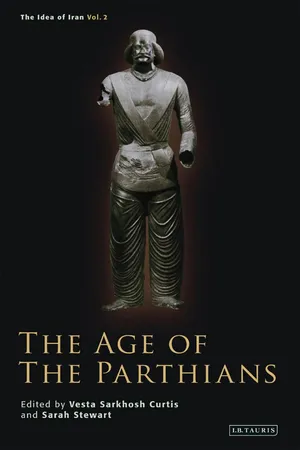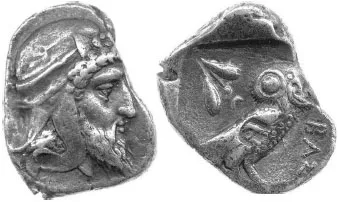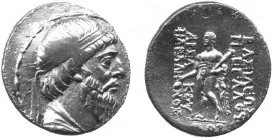![]()
1
The Iranian Revival in the Parthian Period
Vesta Sarkhosh Curtis (The British Museum)
After the conquest of the Achaemenid empire by Alexander of Macedon in 330 BCE and during the subsequent rule of the Seleucid dynasty over the former Persian empire, the two former Achaemenid satrapies of Hyrcania (modern Gurgan) and Parthava (Khurasan) were amalgamated into the province of Parthia.1 According to Justin (12.4.12), the Seleucid ruler Antiochus I (281-261 BCE) appointed a Persian named Andragoras as satrap of the province of Parthia. Andragoras’ name appears on coins and is also attested in a Greek inscription.2
Towards the end of the reign of Antiochus II (261-246 BCE) Andragoras rebelled against his Seleucid overlord and minted gold and silver coins. A gold stater bearing the inscription ΑΝ∆ΡΑΓΟΡΟΥ shows on the obverse a bearded figure wearing a diadem looking to the right (Fig. 1). The reverse depicts a chariot drawn by four galloping horned horses. Nike/Victory drives the chariot and an armoured figure, wearing a cuirass, stands behind her. Andragoras’ name appears below the chariot. Silver tetradrachms show on the obverse a goddess wearing a stepped mural crown looking right. The reverse has a standing Athena with helmet, long chiton and mantle holding an owl in her outstretched right hand, the left hand resting on her shield. Here, the name appears vertically on the right, behind the goddess.3
Fig. 1. Gold coin of Andragoras. The British Museum.
Meanwhile, a man called Arsaces, of Scythian or Bactrian4 origin, was elected leader of the Parni tribes in 247 BCE. This date marks the beginning of the Arsacid era. The Parni or Aparni were part of the confederacy of the Dahae and lived along the river Ochus southeast of the Caspian Sea. Less than ten years after the rebellion of Andragoras against the Seleucids, in 238 BCE, Arsaces and his brother Tiridates invaded the satrapy of Parthia, killed Andragoras and established control over this province.5
The language of Parthia at this time was Parthian, which linguistically is related to Median and belongs to the family of West Iranian languages.6 The Parni newcomers abandoned their own language in favour of Parthian.7 The Parni, whose speech was described by Justin as “midway between Scythian and Median, and contained features of both”, now became known as the Arsacids or Parthians.8
Their kings all took the throne name Arsaces, following the founder of the dynasty. This has made it difficult to identify many Arsacid Parthian kings on coins and cuneiform inscriptions. Strabo (XV.i.36) writes:
…such is also the custom among the Parthians; for all are called Arsaces, although personally one king is called Orodes, another Phraates, and another something else.
The earliest coins are those of Arsaces I (c. 238-211 BCE) and Arsaces II (c. 211-191 BCE) which were perhaps minted at Mithradatkirt or Nisa, now in the Republic of Turkmenistan. They show the head of the ruler on the obverse and a seated archer on the reverse, both turned to the right in the Seleucid fashion. Soon, however, the direction of the king’s head is changed to the left (Fig. 2).9
The soft cap with the top bent over to one side, worn by the ruler, seems to have derived from the tall, pointed Scythian hat, which appears on late sixth-century and fifth-century Achaemenid reliefs (e.g Bisitun and Persepolis).10
The coin legends are in Greek, giving the throne name “Arsaces”, and sometimes the additional title autocrat.11
Fig. 2. Silver coin of Arsaces I. The British Museum.
Fig. 3. Silver coin of satrap Tissaphernes. The British Museum.
Fig. 4. Silver coin of satrap Autophradates. The British Museum.
Both the obverse and reverse type of these early coins are remarkably similar to the pre-Hellenistic coins of the Persian satraps. The combination of a soft hat with earflap and neckguard and diadem can be seen on coins of the satraps Tissaphernes, c. 420-395 BCE (Fig. 3), Spithridates, c. 440-330 BCE,12 and Autophradates, c. 380-320 BCE (Fig. 4).
This type of headdress is not unlike the soft hats worn by Delegation I, the Medes, and other Iranian peoples on the reliefs of the Apadana at Persepolis.13 Perhaps Arsaces adopted this type of hat after his conquest of Parthia.14 The seated figure on the reverse resembles the archer shown on coins of Tarkamuwa, formerly known as Datames, of the fourth century BCE (Fig. 5). This could indicate that the coins of the western satraps of the Achaemenid empire must have been known to the early Arsacids once they took over power in Parthia.
Fig. 5. Silver coin of satrap Tarkamuwa (Datames). The British Museum.
The geographical expansion of Parthia and the political consolidation of the early Parthian kingdom is associated with Mithradates (Mihrdad) I (c. 171-138 BCE). Silver drachms of this ruler show him first with a soft hat (Fig. 6), similar to coins of Arsaces I and II, but soon a new type of portrait appears on his coins. Mithradates abandons the floppy hat and instead appears with only a diadem (Fig. 7). He adopts the image of a Hellenistic ruler,15 but appears bearded in the Iranian/Near Eastern tradition. A fragment of a male head from the excavations at New Nisa may represent Mithradates.16 Both here and on his coins he looks remarkably similar to the bearded Andragoras (cf. Fig. 1), the satrap of Parthia, who was deposed by Arsaces I. The long beard was not uncommon amongst the Seleucids and Demetrius II is shown as a bearded ruler on tetradrachms from Antioch.17
The progression of titles employed on the coins of Mithradates is also interesting. First we read the plain “of Arsaces”, then “of King Arsaces”, and finally “of the Great King Arsaces” (Figs. 6-8). We also find on these coins the extended title “whose father is a god” (ΘΕΟΠΑΤΟΡΟΣ), an epithet which is repeated again under Phraates (Farhad), Mithradates’ son, and Artabanus (Ardavan), Mithradates’ brother. This particular epithet was not usual amongst the Seleucid kings,18 but coins of the Greco-Bactrian ruler Antimachus I (c. 180-170 BCE) have as part of the legend the title ВАΣІΛЕΩΣ ΘЕОΥ “of divine king”.19
Figs. 6-7. Silver coins of Mithradates I (Mihrdad). The British Museum.
Fig. 8. Silver coin of Mithradates I (Mihrdad). The British Museum.
In June 149/8 BCE, the western part of Iran, that is Media, was still under the control of the Seleucids. This is indicated by a dated Greek inscription from Bisitun, which mentions a certain Kleomenes as “Viceroy of the Upper Satrapies”.20 But soon afterwards, in 148 or 147 BCE, Mithradates took Ecbatana (modern Hamadan) and the region came under the control of the Arsacid Parthians.
Southwestern Iran was still under Seleucid rule around 150 BC, but internal struggles between De...







